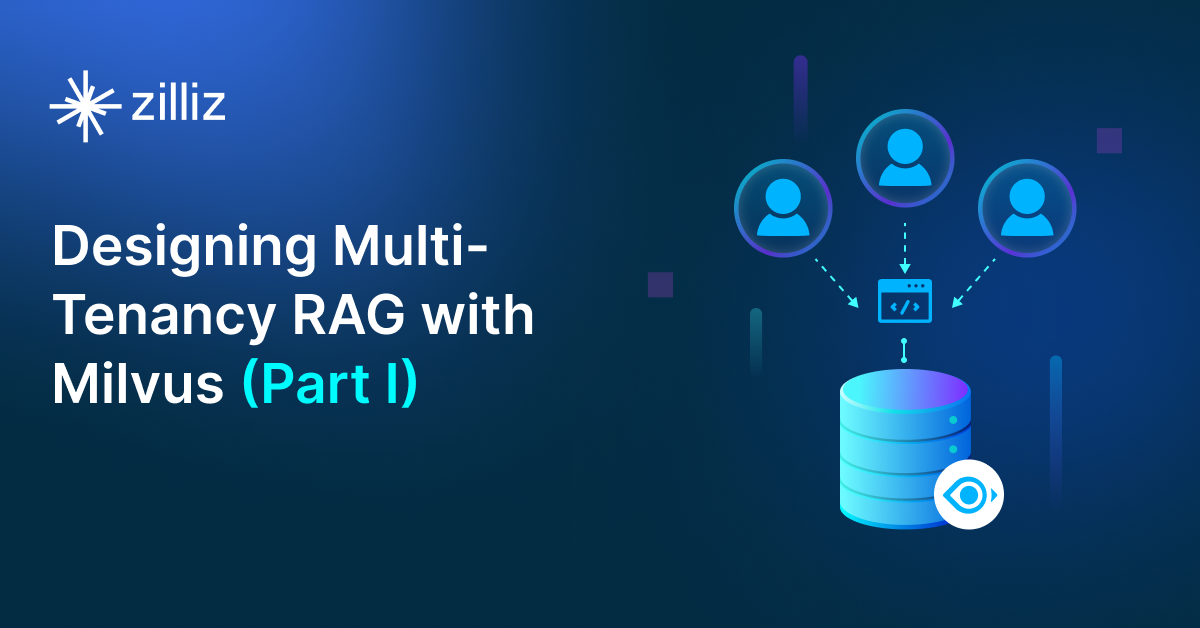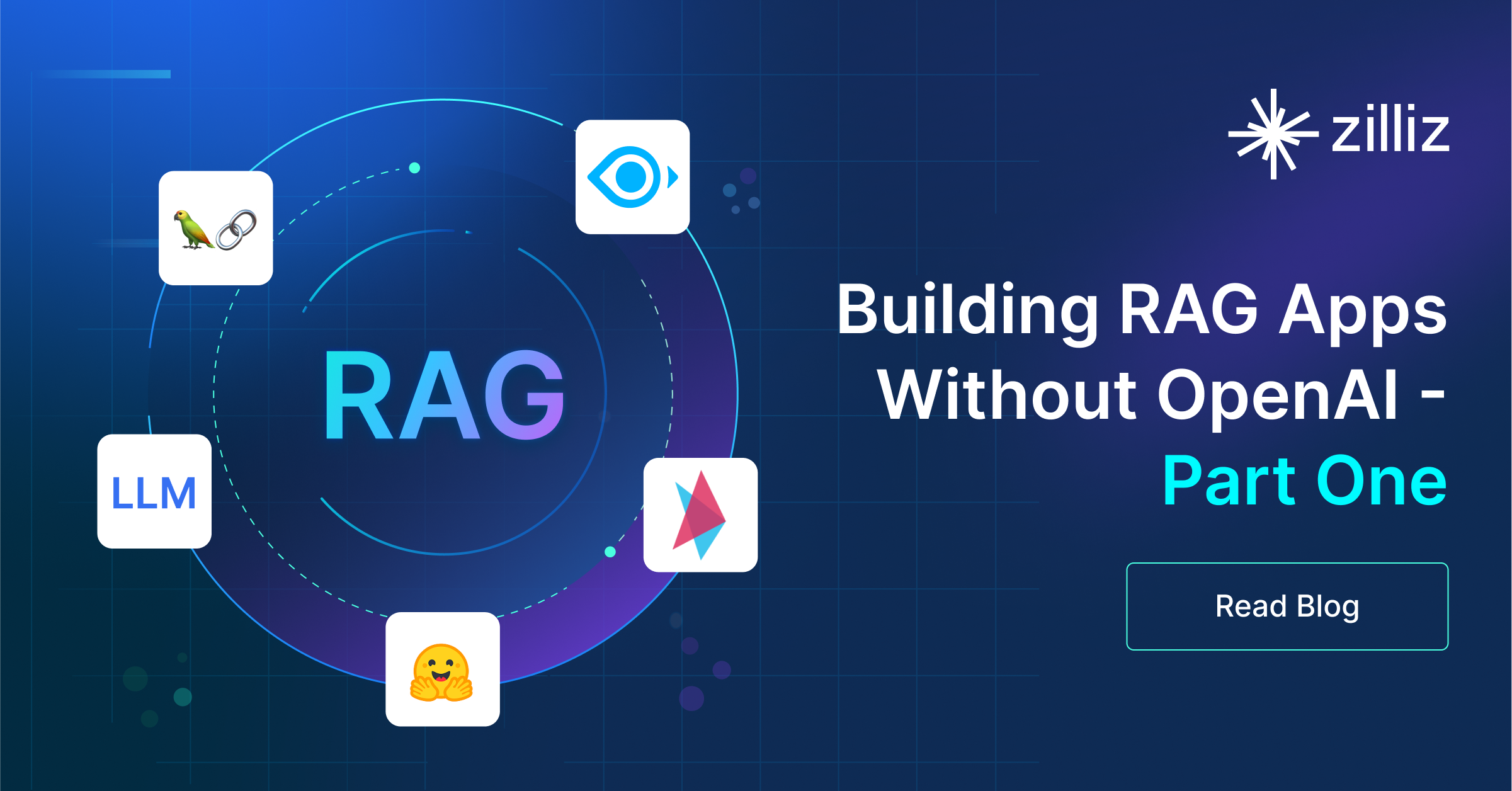Build RAG Chatbot with Haystack, Haystack In-memory store, Mistral Pixtral Large, and Mistral Embed
Introduction to RAG
Retrieval-Augmented Generation (RAG) is a game-changer for GenAI applications, especially in conversational AI. It combines the power of pre-trained large language models (LLMs) like OpenAI’s GPT with external knowledge sources stored in vector databases such as Milvus and Zilliz Cloud, allowing for more accurate, contextually relevant, and up-to-date response generation. A RAG pipeline usually consists of four basic components: a vector database, an embedding model, an LLM, and a framework.
Key Components We'll Use for This RAG Chatbot
This tutorial shows you how to build a simple RAG chatbot in Python using the following components:
- Haystack: An open-source Python framework designed for building production-ready NLP applications, particularly question answering and semantic search systems. Haystack excels at retrieving information from large document collections through its modular architecture that combines retrieval and reader components. Ideal for developers creating search applications, chatbots, and knowledge management systems that require efficient document processing and accurate information extraction from unstructured text.
- Haystack in-memory store: a very simple, in-memory document store with no extra services or dependencies. It is great for experimenting with Haystack, and we do not recommend using it for production. If you want a much more scalable solution for your apps or even enterprise projects, we recommend using Zilliz Cloud, which is a fully managed vector database service built on the open-source Milvusand offers a free tier supporting up to 1 million vectors.)
- Mistral Pixtral Large: A high-performance language model optimized for advanced natural language processing tasks, excelling in multilingual understanding, contextual accuracy, and scalable deployment. Its efficiency in processing complex queries and real-time data makes it ideal for enterprise applications like AI-driven analytics, dynamic content generation, and multilingual customer support automation.
- Mistral Embed: A high-performance embedding model designed to convert text into dense vector representations, capturing semantic meaning for tasks like retrieval, clustering, and similarity analysis. It excels in efficiency, multilingual support, and scalability, making it ideal for semantic search engines, multilingual content organization, and large-scale data processing applications requiring rapid, context-aware text analysis.
By the end of this tutorial, you’ll have a functional chatbot capable of answering questions based on a custom knowledge base.
Note: Since we may use proprietary models in our tutorials, make sure you have the required API key beforehand.
Step 1: Install and Set Up Haystack
import os
import requests
from haystack import Pipeline
from haystack.components.converters import MarkdownToDocument
from haystack.components.preprocessors import DocumentSplitter
from haystack.components.writers import DocumentWriter
Step 2: Install and Set Up Mistral Pixtral Large
To use Mistral models, you need first to get a Mistral API key. You can write this key in:
- The
api_keyinit parameter using Secret API - The
MISTRAL_API_KEYenvironment variable (recommended)
Now, after you get the API key, let's install the Install the mistral-haystack package.
pip install mistral-haystack
from haystack_integrations.components.generators.mistral import MistralChatGenerator
from haystack.components.generators.utils import print_streaming_chunk
from haystack.dataclasses import ChatMessage
from haystack.utils import Secret
generator = MistralChatGenerator(api_key=Secret.from_env_var("MISTRAL_API_KEY"), streaming_callback=print_streaming_chunk, model='pixtral-large-latest')
Step 3: Install and Set Up Mistral Embed
pip install mistral-haystack
from haystack_integrations.components.embedders.mistral.text_embedder import MistralTextEmbedder
from haystack import Document
from haystack_integrations.components.embedders.mistral.document_embedder import MistralDocumentEmbedder
text_embedder = MistralTextEmbedder(api_key=Secret.from_token("<your-api-key>"), model="mistral-embed")
document_embedder = MistralDocumentEmbedder(api_key=Secret.from_token("<your-api-key>"), model="mistral-embed")
Step 4: Install and Set Up Haystack In-memory store
from haystack.document_stores.in_memory import InMemoryDocumentStore
from haystack.components.retrievers import InMemoryEmbeddingRetriever
document_store = InMemoryDocumentStore()
retriever=InMemoryEmbeddingRetriever(document_store=document_store))
Step 5: Build a RAG Chatbot
Now that you’ve set up all components, let’s start to build a simple chatbot. We’ll use the Milvus introduction doc as a private knowledge base. You can replace it your own dataset to customize your RAG chatbot.
url = 'https://raw.githubusercontent.com/milvus-io/milvus-docs/refs/heads/v2.5.x/site/en/about/overview.md'
example_file = 'example_file.md'
response = requests.get(url)
with open(example_file, 'wb') as f:
f.write(response.content)
file_paths = [example_file] # You can replace it with your own file paths.
indexing_pipeline = Pipeline()
indexing_pipeline.add_component("converter", MarkdownToDocument())
indexing_pipeline.add_component("splitter", DocumentSplitter(split_by="sentence", split_length=2))
indexing_pipeline.add_component("embedder", document_embedder)
indexing_pipeline.add_component("writer", DocumentWriter(document_store))
indexing_pipeline.connect("converter", "splitter")
indexing_pipeline.connect("splitter", "embedder")
indexing_pipeline.connect("embedder", "writer")
indexing_pipeline.run({"converter": {"sources": file_paths}})
# print("Number of documents:", document_store.count_documents())
question = "What is Milvus?" # You can replace it with your own question.
retrieval_pipeline = Pipeline()
retrieval_pipeline.add_component("embedder", text_embedder)
retrieval_pipeline.add_component("retriever", retriever)
retrieval_pipeline.connect("embedder", "retriever")
retrieval_results = retrieval_pipeline.run({"embedder": {"text": question}})
# for doc in retrieval_results["retriever"]["documents"]:
# print(doc.content)
# print("-" * 10)
from haystack.utils import Secret
from haystack.components.builders import PromptBuilder
retriever=InMemoryEmbeddingRetriever(document_store=document_store)
text_embedder = MistralTextEmbedder(api_key=Secret.from_token("<your-api-key>"), model="mistral-embed")
prompt_template = """Answer the following query based on the provided context. If the context does
not include an answer, reply with 'I don't know'.\n
Query: {{query}}
Documents:
{% for doc in documents %}
{{ doc.content }}
{% endfor %}
Answer:
"""
rag_pipeline = Pipeline()
rag_pipeline.add_component("text_embedder", text_embedder)
rag_pipeline.add_component("retriever", retriever)
rag_pipeline.add_component("prompt_builder", PromptBuilder(template=prompt_template))
rag_pipeline.add_component("generator", generator)
rag_pipeline.connect("text_embedder.embedding", "retriever.query_embedding")
rag_pipeline.connect("retriever.documents", "prompt_builder.documents")
rag_pipeline.connect("prompt_builder", "generator")
results = rag_pipeline.run({"text_embedder": {"text": question}, "prompt_builder": {"query": question},})
print('RAG answer:\n', results["generator"]["replies"][0])
Optimization Tips
As you build your RAG system, optimization is key to ensuring peak performance and efficiency. While setting up the components is an essential first step, fine-tuning each one will help you create a solution that works even better and scales seamlessly. In this section, we’ll share some practical tips for optimizing all these components, giving you the edge to build smarter, faster, and more responsive RAG applications.
Haystack optimization tips
To optimize Haystack in a RAG setup, ensure you use an efficient retriever like FAISS or Milvus for scalable and fast similarity searches. Fine-tune your document store settings, such as indexing strategies and storage backends, to balance speed and accuracy. Use batch processing for embedding generation to reduce latency and optimize API calls. Leverage Haystack's pipeline caching to avoid redundant computations, especially for frequently queried documents. Tune your reader model by selecting a lightweight yet accurate transformer-based model like DistilBERT to speed up response times. Implement query rewriting or filtering techniques to enhance retrieval quality, ensuring the most relevant documents are retrieved for generation. Finally, monitor system performance with Haystack’s built-in evaluation tools to iteratively refine your setup based on real-world query performance.
Haystack in-memory store optimization tips
Haystack in-memory store is just a very simple, in-memory document store with no extra services or dependencies. We recommend that you just experiment it with RAG pipeline within your Haystack framework, and we do not recommend using it for production. If you want a much more scalable solution for your apps or even enterprise projects, we recommend using Zilliz Cloud, which is a fully managed vector database service built on the open-source Milvusand offers a free tier supporting up to 1 million vectors
Mistral Pixtral Large optimization tips
To optimize Mistral Pixtral Large in a RAG setup, prioritize chunk sizing for retrieval—experiment with 256-512 token chunks to balance context and relevance. Use dense embeddings (e.g., SBERT) paired with hybrid search (ANN + keyword) for efficient document retrieval. Fine-tune the model on domain-specific data to enhance response accuracy. Adjust generation parameters: lower temperature (0.2-0.4) for factual consistency and limit top-k to 50-100. Implement query caching for repetitive inputs and use metadata filtering to prune irrelevant documents. Regularly evaluate retrieval hit rate and latency to refine thresholds and indexing strategies.
Mistral Embed optimization tips
To optimize Mistral Embed in a RAG setup, preprocess text by removing redundant whitespace, special characters, and normalizing casing to reduce embedding noise. Use batch processing for bulk embeddings to leverage GPU parallelism. Fine-tune Mistral Embed on domain-specific data if retrieval accuracy is low. Reduce input sequence length via truncation or sliding windows for long documents. Cache frequent queries to save compute. Test different pooling strategies (mean, max) for sentence-level embeddings and normalize outputs to improve similarity scoring consistency.
By implementing these tips across your components, you'll be able to enhance the performance and functionality of your RAG system, ensuring it’s optimized for both speed and accuracy. Keep testing, iterating, and refining your setup to stay ahead in the ever-evolving world of AI development.
RAG Cost Calculator: A Free Tool to Calculate Your Cost in Seconds
Estimating the cost of a Retrieval-Augmented Generation (RAG) pipeline involves analyzing expenses across vector storage, compute resources, and API usage. Key cost drivers include vector database queries, embedding generation, and LLM inference.
RAG Cost Calculator is a free tool that quickly estimates the cost of building a RAG pipeline, including chunking, embedding, vector storage/search, and LLM generation. It also helps you identify cost-saving opportunities and achieve up to 10x cost reduction on vector databases with the serverless option.
 Calculate your RAG cost
Calculate your RAG cost
What Have You Learned?
By now, you’ve unlocked the magic of building a powerful RAG system from the ground up! You learned how Haystack, the flexible framework, acts as the backbone, seamlessly connecting every piece of the puzzle. With the Haystack In-memory Store as your vector database, you saw how lightning-fast retrieval works by storing and querying embeddings efficiently—no complex setup required. Then came Mistral Embed, the embedding model that transforms text into rich numerical representations, giving your system the ability to “understand” context and meaning. And let’s not forget Mistral Pixtral Large, the LLM powerhouse that generates human-like answers by synthesizing retrieved data into coherent, natural responses. Together, these tools form a dynamic pipeline that pulls in relevant information and crafts intelligent answers, all while keeping things lightweight and scalable. You’ve also picked up pro tips for optimizing performance, like fine-tuning chunk sizes and balancing speed with accuracy, plus how to use the free RAG cost calculator to estimate expenses and make budget-friendly decisions. Talk about leveling up your toolkit!
But this is just the beginning. Imagine what you can create now—custom chatbots, research assistants, or even AI-driven knowledge bases tailored to your needs. The skills you’ve gained aren’t just about following steps; they’re about empowering you to innovate. Whether you’re refining your pipeline, experimenting with hybrid search strategies, or integrating new data sources, the possibilities are endless. So go ahead—dive in, tweak those parameters, and let your creativity run wild. The future of intelligent applications is yours to shape, and with what you’ve learned today, you’re more than ready to build something amazing. Let’s get coding, optimizing, and pushing the boundaries of what RAG can do. Your next breakthrough is waiting!
Further Resources
🌟 In addition to this RAG tutorial, unleash your full potential with these incredible resources to level up your RAG skills.
- How to Build a Multimodal RAG | Documentation
- How to Enhance the Performance of Your RAG Pipeline
- Graph RAG with Milvus | Documentation
- How to Evaluate RAG Applications - Zilliz Learn
- Generative AI Resource Hub | Zilliz
We'd Love to Hear What You Think!
We’d love to hear your thoughts! 🌟 Leave your questions or comments below or join our vibrant Milvus Discord community to share your experiences, ask questions, or connect with thousands of AI enthusiasts. Your journey matters to us!
If you like this tutorial, show your support by giving our Milvus GitHub repo a star ⭐—it means the world to us and inspires us to keep creating! 💖
- Introduction to RAG
- Key Components We'll Use for This RAG Chatbot
- Step 1: Install and Set Up Haystack
- Step 2: Install and Set Up Mistral Pixtral Large
- Step 3: Install and Set Up Mistral Embed
- Step 4: Install and Set Up Haystack In-memory store
- Step 5: Build a RAG Chatbot
- Optimization Tips
- RAG Cost Calculator: A Free Tool to Calculate Your Cost in Seconds
- What Have You Learned?
- Further Resources
- We'd Love to Hear What You Think!
Content
Vector Database at Scale
Zilliz Cloud is a fully-managed vector database built for scale, perfect for your RAG apps.
Try Zilliz Cloud for Free


